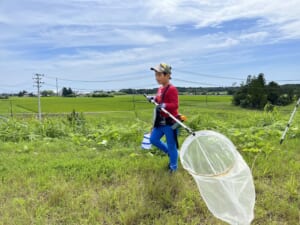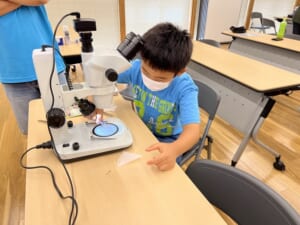Professor Tomisato Miura and Project Assistant Professor Donovan Anderson of the Department of Risk Analysis and Biodosimetry conducted the “Health, Environment and Disaster Prevention Education Programme for Developing Local Human Resources to Follow Up on the Reconstruction of Namie Town” as part of the “Project for Establishing a Human Resources Development Platform Using ‘Reconstruction Knowledge’ from Universities and Other Institutions”, which was selected by the Fukushima Innovation Coast Initiative. As part of the ‘Health, Environment and Disaster Prevention Education Programme for Developing Local Human Resources to Follow-up Namie Town’s Recovery’, a ‘Biodiversity Assessment Hands-on Learning Programme’ was implemented. In this programme, Namie Town elementary and junior high school students collect insects in various ecosystems in Namie Town. Program participants are supported by Hirosaki University students. The focus of the program is to learn about the relationship between the environment and living organisms, biodiversity, and the recovery of the natural environment through insects.
On 6-7 August 2022, one Namie Sousei primary school student, his father, and three teachers from Namie Sousei primary and junior high schools participated in the program. The participants were supported by three fourth-year students and two graduate students from the Hirosaki University. Insects collected around Kanagamori Tameike (Tanashio area) and around Ohirayama Cemetery (Ukedo area) were identified and the biota of the two sites were compared. Namie town is blessed with a rich natural environment, but the 2011 nuclear power plant accident following the Great East Japan Earthquake has restricted opportunities for children to enjoy nature and outdoor activities because of the fear from radiation exposure. Unfortunately, the number of participants was low this year, but we hope to continue providing opportunities for children to learn about their hometown’s natural environment, environmental restoration, and the town’s regeneration through their own experiences.



-300x225.jpg)

